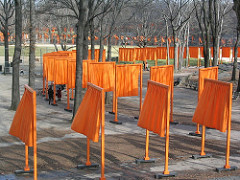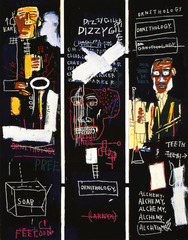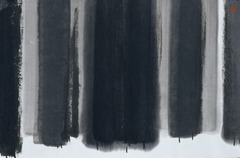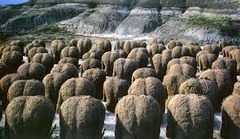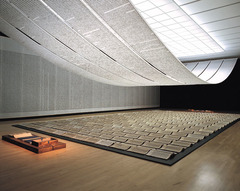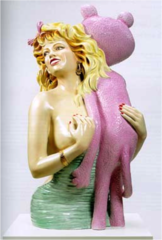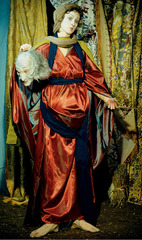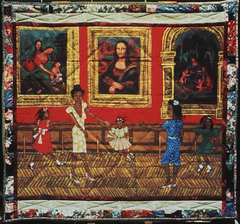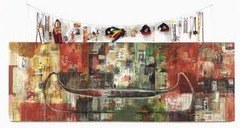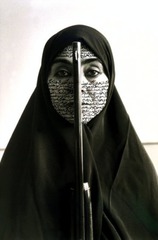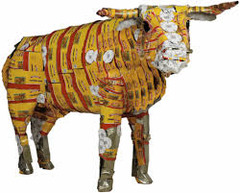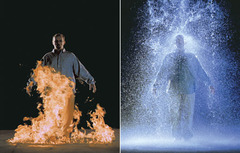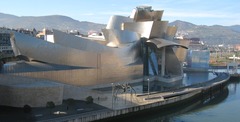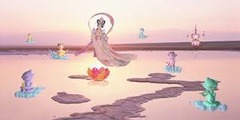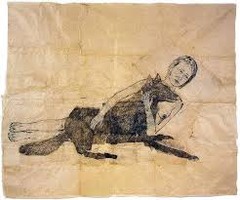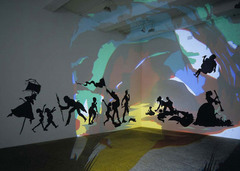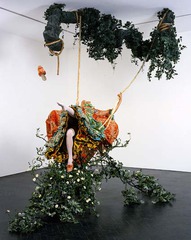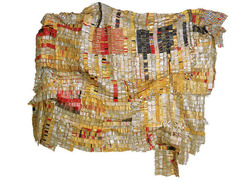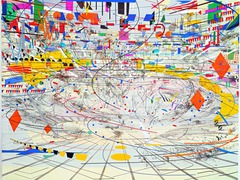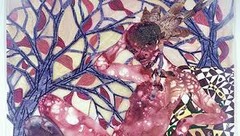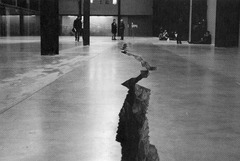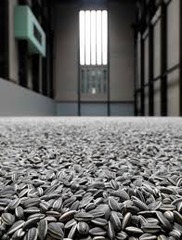The Gates. New York City, U.S. Christo and Jeanne-Claude. 1979-2005 C.E. Mixed-media installation.
Name: The Gates
DOC:
1979-2005
Period:
Modernism
Style:
Contemporary, Temporary art
Technique:
Material:
Two steel footing, supported saffron-colored fabric panels that hung loosely from the top
Parton:
The city of New York
Origin:
New York City, New York
Content:
7,503 gates ran over 23 miles of walkways; each gate was 16 feet high, with width varying according to the paths width
Meaning:
To appear like a golden river running through the park
Significance:
It shows how to create meaningful public art and how the art impacts our society with the built environment
Vietnam Veterans Memorial. Washington, D.C., U.S. Maya Lin. 1982 C.E. Granite.
#225
N: Vietnam Veterans Memorial
D: November 13, 1982 P/S: Post Modernism
A: Maya Lin
Pa: Congress of United States
OL: Washington D.C, U.S.A
M: Gabbros and Black Granite T: Memorial
F: Honors those in the armed forces who fought and died in the Vietnam War
C: Over 58,000 Americans were killed while over 300,000 Americans were injured during the Vietnam War (1955-1975)
DT: Photo Emulsion, Sandblasting, and Optima Typeface
M: A symbol of American honor and respect to those who sacrificed themselves and fought in the Vietnam War
"Memorial." Vietnam Veterans Memorial Fund. Vietnam Veterans Memorial Fund. Web. 24 Feb. 2015.
Horn Players. Jean-Michel Basquiat. 1983 C.E. Acrylic and oil paintstick on three canvas panels.
Name: Horn Players
Date: 1983 C.E Period/Style: Post Modern Art, more specifically Neo-Expressionism
Author: Jean-Michel Basquiat
Original Location: New York
Material: Acrylic and oil paintstick on three canvas panels
Technique: N/A
Function: This piece was made to show Basquiat's respect to legendary jazz artists Dizzy Gillepsie and Charlie Parker-the two figures depicted in the painting.
Context: The late 1900s the African American community was bustling with creativity and rich culture-especially in New York where Basquiat was located. This time period saw to the emergence of hiphop and rap. Michael Jackson was actively promoting.
Descriptive Term: Urgent application, hurried lettering
Meaning: I believe Basquiat created the piece to show his pride in being a member of the Black community.
Summer Trees. Song Su-nam. 1983 C.E. Ink on paper.
N: Summer trees
D: 1983 CE P/S: Contemporary/Abstract
A: Song Su-nam
Pa: None
OL: Korea
M: Ink on paper T: Painted
F: It recalls the landscapes of Chinese and Korean portraitures.
C: He wanted to show appreciation for the ancient Asian brush techniques and to redisplay/re-envoke the Asian landscape.
DT: Summer Trees, Song Su-Nam, ink, abstract, contemporary, modern day, painted, paper, Korean, landscapes
M: This painting blends traditional subtle brush techniques with modern day style and
Androgyn III. Magdalena Abakanowicz. 1985 C.E. Burlap, resin, wood, nails, string.
N: Androgyn III D: 1985 C.E.
P/S: Postmodernism Art
A: Magdalena Abakanowicz
Pa: Unknown
OL: Poland
M: Burlap, resin, wood, nails, and string T: Sculpture
F: The artist excluded the headed, arms, and legs in the figure, because she wanted to convey the message that any human being is identical with one another when considered from a universal perspective. Through this provocative image, the artist expresses the physical and spiritual composition of mankind. As she says, "they are about existence in general"
C: The figure is hollow and stands like an empty shell, a natural metaphor for the hollowness, both physical and spiritual, that racked postwar Europe.
DT: Mundane, austere, rough texture, peaceful, androgynous, organic
M: The creases, ridges, and veins of the hardened-fiber surface assume organic characteristics, reminiscent of the earth's rough surface or the cellular composition of human skin. The artist felt that it was these characteristics and manifestations that make fiber the base unit of the universe.
A Book from the Sky. Xu Bing. 1987-1991 C.E. Mixed-media installation.
Name: A Book from the Sky
Date: 1987 - 1991
Period/Style: Global Contemporary/ 1980 C.E. to Present
Artist: Xu Bing
Patron: N/A
Original location: Beijing, China
Material: Mixed - Media Installation
Technique: The book's characters were carved into individual pieces of movable type made from pear wood, in a style slightly squatter than that of Song typefaces.
Function: The book is written in the style of fine editions from the Song and Ming dynasties, but filled entirely with meaningless glyphs designed to resemble traditional Chinese characters.
Context: The characters are composed using a set of 4,000 characters, as this is roughly the number of characters in common usage in modern written Mandarin.
Descriptive Terms: The book, which consists of four volumes totaling 604 pages, was printed in a single print run of 126 copies between 1987 and 1991.
Meaning: Xu Bing deliberately combined powerful cultural icons with emotionally laden issues, and left the interpretation open to the audience and Xu Bing himself wasn't certain what the work's ultimate meaning will be, and he seems to accept that defining meaning can be the prerogative of both artist and audience.
Pink Panther. Jeff Koons. 1988 C.E. Glazed porcelain.
N: Pink Panther
D: 1988 C.E. P/S: c.1970-present / postmodernism
A: Jeff Koons
Pa: None
OL: United States
M: Porcelain on Formica base T: sculpting
C: This piece is a part of his Banality series. It is a reflection of pop culture, juxtaposing the namesake popular children's' cartoon character with Jayne Mansfield, a sex symbol. Four essentially identical Pink Panther sculptures exist. They are an example of kitsch, meant to appeal to the masses. This piece later grew to be considered high art due to its popularity.
F: To sell in the market.
DT: Bright colors, sexually suggestive
M: "Pink Panther is about masturbation. I don't know what she would be doing with the Pink Panther other than taking it home to masturbate with." - Jeff Koons
Untitled (#228), from the History Portraits series. Cindy Sherman. 1990 C.E. Photograph.
N: Untitled (#228), from the History Portraits Series
A: Cindy Sherman
P: N/A
P/S:
Location: Rome, Italy
D: 1990
M: Photograph
C:Sherman served as model, set-dresser, and photographer for her History Portraits. Drawing from a range of art-historical styles and periods, including the Renaissance, Baroque, Rococo, and Neoclassical, and alluding to canonical paintings, she used costuming and settings to transform herself into the historical-looking male and female figures at the center of each photograph. Full of obvious prostheses, bad wigs, and theatrical makeup, the images are made to appear artificial. By revealing her disguise, she demonstrates that her pictures are constructs; through them, she draws attention to the staged and often mannered nature of historical portrait paintings, while also playfully mocking the discipline of art history.
F: Explore female identity
Dancing at the Louvre, from the series The French Collection, Part I; #1. Faith Ringgold. 1991 C.E. Acrylic on canvas, tie-dyed, pieced fabric border.
N: Dancing at the Louvre, from the series The French Collection, Part I; #1
D: 1991 C.E. P/S: post-modernism
A: Faith Ringgold
P: N/A
OL: France, Europe
M: Acrylic on canvas, tie-dyed, pieced fabric border
T: representational painting and African-American quilting techniques
F: To break boundaries and combine a multitude of artistic techniques. Combines Modern art, African-American culture, and personal experiences
C: First of 12 "story quilts" In the French Collection
M: To tell a fictional story of a young black women who moves to Paris in the early 20th century. Her adventures lead her through history and meet a multitude of celebrities such as Pablo Picasso and Sojourner Truth.
Trade (Gifts for Trading Land with White People). Jaune Quick-to-See Smith. 1992 C.E. Oil and mixed media on canvas.
N: Trade (Gifts for Trading Land with White People)
D: 1992 C.E. P/S: Post Modernism
A: Jaune Quick-to-See Smith
Pa: N/A
OL: Virginia
M: Oil, mixed media, and canvas.
T: Oil and mixed media on canvas.
F: Illustrates historical and contemporary inequities between Native Americans and the United States government.
C: 500 years after Columbus arrival in North America.
DT: Allegories, historical, colonizers, mixed media.
M: Jaune Quick-to-See Smith illustrated the way the colonizers took advantage of the Native Americans by trading with them useless trinkets for their land and argued that if the colonizers wouldn't take these trinkets back for the very same land then it wasn't a fair deal.
Earth's Creation. Emily Kame Kngwarreye. 1994 C.E. Synthetic polymer paint on canvas.
N: Earth's Creation
D: 1994 P/S: Contemporary Indigenous Australian art
A: Emily Kame Kngwarreye
Pa: none
OL: Utopia, Australia
M: Synthetic polymer paint on canvas
T: Dump dot technique - using the brush to pound the paint onto the canvas and create layers of colour and movement.
F: Personal expression
C: Emily is Australia's most important Aboriginal artist. She was the first aboriginal to have a work sell for over a million dollars and remains the only Australian - of any background - to have an overseas retrospective held in their name. She was known not have any knowledge or training in art, and painted in a way that has never been seen.
DT: original, hard brush strokes, abstract
M: The painting represents everything - in Kngwarreye's words "Whole lot."
Rebellious Silence, from the Women of Allah series. Shirin Neshat (artist); photo by Cynthia Preston. 1994 C.E. Ink on photograph.
N: Rebellious Silence, from the Women of Allah series
D: 1994 C.E. P/S: Contemporary Art/ Massurealism
A: Shirin Neshat(artist), photo by Cynthia Preston.
Pa: N/A
OL: Unknown
M: Ink on photograph T: Photography
F: Described the social issues ranging from stereotypes to war in a woman's point of view in their works
C: Iranians Islamic Revolution of 1979, women of war and their stance
DT: Photograph, Farsi decorates the artists face, black and white, image shows a veiled woman with the barrel of a gun pointing straight up dividing her face. Her gaze looks directly at the viewer with unwavering confidence.
M: Expresses the abstract thoughts of "female warriors during the Iranian Islamic Revolution of 1979", the photograph is inscribed with calligraphy of farsi text on the face; the text is poetry of the contemporary Iranian women poets who had written on the subject of martyrdom and the role of women in the revolution.
En la Barberia no se Llora (No Crying Allowed in the Barbershop). Pepon Osorio. 1994 C.E. Mixedmedia installation.
...
Pisupo Lua Afe (Corned Beef 2000). Michel Tuffery. 1994 C.E. Mixed media.
N: Pisupo Lua Afe (Corned Beef 200)
D: 1994 P/S: Postmodernism Art
A: Michel Tuffery
Pa: Unknown
OL: New Zealand
M: Flattened and riveted recycled corn beef tins, steel T: Sculpture
F: To comment on how an imported commodity has become an integral part of the Polynesian customs of feasting and gift giving
C: In the 1960s, former Chief Justice of Samoa C C Marsack wrote that 'when Samoans were first introduced to the wonder of tinned food, this was in the form of pea soup. As no Samoan word can end in a consonant, they tacked an "o" on the end and made the Samoan form of the English term pisupo, pronounced pea-soup-o. As time wore on and other edible matter arrived in tins, the generic term pisupo was used for all of it. Now it is more or less confined to tinned meat.' In the Pacific Islands there are many traditional gifts of exchange such as fine mats and tapa cloth. However, at weddings, funerals, feasts, or other special occasions, tins of pisupo (corned beef) might be eaten and also given as gifts. Tinned Pisupo not only plays an important role in the Pacific Island diet, but in the culture as well.
DT: Light-hearted, historical, complex, provocative, colorful, rough texture, metallic
M: The meaning of this work is to raise questions about the effects colonial economies have had on Pacific peoples and whether foreign intervention actually encourages independence or fosters dependency. The way in which it is presented is very different and shocking.
Electronic Superhighway. Nam June Paik. 1995 C.E. Mixed-media installation (49-channel closedcircuit video installation, neon, steel, and electronic components).
...
The Crossing. Bill Viola. 1996 C.E. Video/sound installation.
N: The Crossing #239
D: 1996 C.E. P/S: Performance Art/ Postmodernism
A: Bill Viola
Pa: N/A
OL: N/A (it is a video and can be played anywhere)
M: Video T: Videography
F: To evoke the viewer's senses and create a feeling of spirituality.
C: Viola focuses much of his artistic talent in making video installations and single-channel works. His work focuses and sensory perception and tries to take viewers on a trip to the spiritual realm. The videos are able to accomplish this through slow motion, contrasts in scale, shifts in focus, mirrored reflections, etc.
DT: Spiritual, sense evoking, terrifying yet soothing
M: In this particular video a man slowly enters the frame until he fills the entire screen. This image is portrayed on two different screens simultaneously. On one screen a small fire breaks out at the man's feet while on the other screen water begins to fall on the man's head. Eventually, the man is being drenched in water and consumed in fire. Finally, the image fades into blackness. The purpose of this video in to immerse viewers in a sensory experience and explain the reality of life.
Guggenheim Museum Bilbao. Spain. Frank Gehry (architect). 1997 C.E. Titanium, glass, and limestone.
N: Guggenheim Museum
D: 1997 P/S: Contemporary
A: Frank Gehry
PA: Basque government
OL: Bilbao, Spain
M: Titanium, glass, and limestone T: Used computer visualizations produced by Digital Project software
F: To showcase great fine art exhibitions and further the redevelopment of the city Bilbao
C: In the late 1980s the Basque authorities started on a redevelopment program for Bilbao. In 1991 at the invitation of the Basque Government the director of the Solomon R. Guggenheim Foundation, met repeatedly with officials and signed a preliminary agreement to bring a new Guggenheim Museum to Bilbao. Was visited by numerous artists, architects, journalists, politicians, filmmakers, and historians during the four years of its construction which anticipated the success of the museum.
DT: Majestic, Modern, Musical, Innovative
M: A museum to challenge assumptions about art museum collecting and programming with its inventive design
Pure Land. Mariko Mori. 1998 C.E. Color photograph on glass.
N: Pure land
D: 1998 P/S: Abstract Expressionist
A: Mariko Mori T: Cibachrome Print
Pa: None
OL: Tokyo, Japan
M: Color Photography on Glass
F: To create a meditative environment that provides the audience with a sense of tranquility and transcendence
C: A still image from her 3D installation titled Nirvana from The Esoteric Cosmos Series
DT: Digitally Generated, Contemporary Aesthetics
M: Allow the viewer to transport to Nirvana, as well as to represent a personal journey
Lying with the Wolf. Kiki Smith. 2001 C.E. Ink and pencil on paper.
Name: Lying with the Wolf
Number on the 250 list: 242
Date: 2001 C. E
Artist: Kiki Smith
Patron: N/A
Original Location: New York
Current Location: Centre Pompidou, Paris
Materials: Ink and pencil on paper, 72 1/4 x 88 inches
Function: "In the Louvre I saw a picture of Genevieve sitting with the wolves and the lambs...I had stopped making images of people for a couple of years; I just wanted to make animals. But then I saw that picture, and I thought, 'It's really important to put them all together.' So I drew my friend Genevieve as the Genevieve, and then I made all these wolves (I didn't make lambs)." —Kiki Smith
Context: Assimilation of several themes that Kiki Smith has explored throughout her decades-long career:
Featuring an act of bonding between human and animal
Reverence for the natural world,
Religious narratives and mythology,
The history of figuration in western art
Contemporary notions of feminine domesticity
Spiritual yearning
Sexual identity.
Descriptive Details: What isn't evident on this page is that Smith's drawing is actually quite large and, in a gallery setting, hangs wrinkled and pinned to the wall, reminding us of a bed sheet, table cloth, or other domestic piece of fabric. The depiction of a woman and dangerous animal so easily coexisting is a powerful visual message, one that reminds us of Biblical characters, figures from Greek myth, and even eastern deities. It is a clear statement of female strength throughout mythological and spiritual history. This pairing of characters also provides us with an updated version of ancient images, since the drawing includes no recent iconography, architecture, personal effects or materials. Smith's drawing offers us a contemporary description of an ancient female force.
Meaning: Feminist theme; we see a nude female figure, reclining as she embraces a wolf. The wolf, a typical figure in myth and fables, is a symbol of evil, temptation or downfall, but here we see a placid wolf, welcoming the woman's embrace. It looks as though, in a peaceful manner, the woman has tamed the wolf.
Period/Style: Feminist Art
Technique: Drawing
Darkytown Rebellion. Kara Walker. 2001 C.E. Cut paper and projection on wall.
N: Darkytown Rebellion
D: 2001 C.E. P/S: Global Contemporary/Postmodernism
A: Kara Walker
Pa: none
OL: Musée d'Art Moderne Grand-Duc Jean, Luxembourg
M: cut paper and projection on wall.
T: black silhouettes against colorful background, sharp lines, distinct and defined shapes.
F: to portray a scene that holds characters that have few distinguishing features, so it becomes hard to tell race, gender, and age; this leads to removal of bias and discrimination so that the viewer see's the scene for what it truly is. Mainly serves to challenge accepted racial stereotypes and broadcast the flaws in popular culture's feelings toward race.
C: The actual subject of the work is meant to reflect the antebellum South during the time of slavery. Many southern African-American stereotypes are still present today and Walker hoped to make viewers realize how subconsciously they had these premeditated ideas about the figures and the assumptions about race they automatically made because of popular culture.
DT: ambiguous, mysterious, nightmarish, surreal, contrasting (black silhouettes and colorful projection), sympathy-inducing.
M: The meaning behind this work of art is that as humans in modern society we allow ourselves to succumb to accepting widely known stereotypes based on race, gender, and age and that we should first look at people for what they are rather than what color they are. Walker portrays this by creating all the silhouettes with black cut-out paper, that way when viewers look at this piece they begin to question why they pictured the figure with a certain skin tone, which further makes them reflect on their accepted stereotypes and the rude perceptions that it encourages. Also Walker shows her support for coexisting with our any discrimination, especially racial, by using a unique blend of multiple colors in the projection that appear to be contrasting colors with jagged and rough lines. This conveys the meaning that by recognizing and addressing the difference in races humans are creating a "jagged" and fragmented society.
The Swing (after Fragonard). Yinka Shonibare. 2001 C.E. Mixed-media installation.
Name: The Swing (after Fragonard)
Date: 2001 C.E. Period/Style: Postmodernism Art
Artist: Yinka Shonibare
Patron: None
Original Location: Sheffield
Materials: dress made of African print fabric Technique: Mixed-media installation
Function: Meant to be seen straight on but due to 3 dimensions viewers can walk around the installation and view from different points, like the original subjects in the painting.
Context: Installation that utilizes a headless female mannequin dressed in traditional eighteenth century dress swinging from a branch that is attached to the ceiling of the gallery. Skirt is lifted and shoe hangs from invisible wire; to show that the subject kicked off her shoe. The work depicts a summary of the scene in the original painting but leaves out some elements of the painting. The two men and most of the green forest background are missing. Installation is a 3D replica of part of the scene in painting.
Descriptive Terms: negative space, asymmetrical
Meaning: Piece is a disjunction to the original piece it was modeled after. The headless mannequin could suggest the fate of the aristocracy following the French revolution. Fabrics used to make up dress are symbol of multi-cultural identity.
Old Man's Cloth. El Anatsui. 2003 C.E. Aluminum and copper wire.
N: Old Man's Cloth
D: 2003 C.E. P/S: Postmodernism/Sankofa
A: El Anatsui
Pa: None
OL: Southern Nigeria
M: Aluminum and copper wire.
T: Uses copper and aluminum wires to fasten together labels and bottle caps from alcoholic beverage containers at the corners.
F: A statement piece to remember his regions history and culture through using elements related to the most influential and culture-shaping events.
C: El Anatsui became an influential artist during a period in which African independence movements were becoming increasingly popular. Also El Anatsui uses his personal background, coming from Ghana, to convey the works greater purpose by using the luminescent gold color to reflect his homes colonial past.
DT: rough, textured, fluid, abstract, metaphorical, geometric.
M: This piece specifically is meant to serve as a reminder of the uneasy history of trade between Europe and Africa. By using bottle caps from alcoholic beverages, it is metaphorically reminding the viewer of the slave trade, which was one of the most influential events in the history of the continent, because alcohol was one of the commodities traded. Also the use of the gold color is connecting the works meaning to The Gold Coast (British colony which is now Ghana) which was exploited by European "trade" with the region and stripped of its resources and the fluid movements of the piece are symbolic of the waves and movements of the Atlantic Ocean, the location of Slave trade. Lastly the name of the piece, Old Man's Cloth, references the significance of the trade of textiles to the history and culture of the region.
Stadia II. Julie Mehretu. 2004 C.E. Ink and acrylic on canvas.
N: Stadia II
D: 2004 C.E P/S: Global Modernism
A: Julie Mehretu
P: N/A
OL: New York
M: Ink and acrylic on canvas
T: unique technique: Project maps/ diagrams onto the piece blank surface. Then traces and makes hash marks. Eventually these develop into shapes and designs. First layer is coated in Acrylic then more figures are created and the cycle repeats.
F: Stadia II is meant to portray a large stadium, A sports arena. Country flags, confetti, and the eruption of the crowd are prevalent.
C: Mehretu connects her art to the ever expanding world. Her dynamism has references to traffic patterns, popular culture, and disorder
M: To convey energy of today's globalized world. Purposely impossible to distinguish one figure from the next
Preying Mantra. Wangechi Mutu. 2006 C.E. Mixed media on Mylar.
N: Preying Mantra
D: 2006 C.E.
P/S: Postmodernism Art A: Wangechi Mutu
P: Unkown
OL: Brooklyn Museum
M: Mixed media on Mylar T: Mixed media collage
F: The function of this piece is to invite viewers to explore the stereotypes about the female African body as explicitly sexual, dangerous, and aesthetically deformed in relation to those of Western lands.
C: This work centers on female subjectivity and the notion of hybridity. In this context, hybridity describes how the mixing of the cultures of colonized and the colonizer - can produce a third space for newer and often disruptive understanding of cultural identity. The artist herself was born in Kenya. As colonialism in Africa waned in the 20th century, other social and political issues emerged, such as the rights of women being impeded.
DT: Resplendent, geometric, cyborgious, relaxed, authentic, suggestive, mosaic
M: The title Preying Mantra recalls the praying mantis, in that the subject's legs are prominently bent. This relation has a dual meaning in that praying mantises, and African women as portrayed by their stereotypes are known to be sexual cannibals during mating season. But Mutu spelled preying with an "e" to convey that the figure may be a victim who is preyed upon mantras.
Shibboleth. Doris Salcedo. 2007-2008 C.E. Installation.
Name: Shibboleth
Date: 2007
Period/Style: Contemporary Art
Artist: Doris Salcedo
Patron: N/A
Original Location: Turbine Hall, London
Material: Floor of the Turbine Hall (Columbian rock)
Technique: N/A
Context: Salcedo, instead of filling the hall with conventional sculpture or
installation, created a large crack on the floor of the Turbine Hall at its installation
Descriptive Terms: Divisive, grand, chaotic, rough
Meaning: The word "shibboleth" is often used to exclude the less worthy from
a specific group and she uses this giant crack on the floor of ceremonial hall as a symbol of racism, discrimination, and colonialism that separated one being from each other. Through this art piece she addresses that the modernity is a result of colonial exploitation of the "stronger" from the "weaker"
MAXXI National Museum of XXI Century Arts. Rome, Italy. Zaha Hadid (architect). 2009 C.E. Glass, steel, and cement.
Name: MAXXI
Date: 2010
Artist: Zaha Hadid
Period/style: Postmodern/contemporary
Technique: architecture
Patron: n/a
Original location: Rome, Italy
Medium: concrete, limestone, glass
Function: contemporary art museum
Context: New architecture, modern architecture. Innovative art style and it derived from the international style
Descriptive terms: repetition, contemporary, innovative, movement, international style
Meaning: The building is repetitive in that the architecture is supposed to mimic movement to depict the progressive-ness of the future of architecture and building.
Kui Hua Zi (Sunflower Seeds). Ai Weiwei. 2010-2011 C.E. Sculpted and painted porcelain.
N: Kui Hua Zi (Sunflower Seeds)
D: 2010-2011 C.E. P/S: Modern/Contemporary (primarily 20th century)
A: Ai Weiwei.
Pa: Tate Modern's Turbine Hall
OL: Turbine Hall
M: Sculpted and painted porcelain.
F:Each piece is part of a whole, depicting the relationship between one and the masses. Which leads to the thoughts of "What does in mean to an individual in todays society? Are we significant or powerless unless we act together? What do our increasing desires, materialism and number mean for society, the environment and the future?"
T:sculpted/painted
C: Work about mass production, and the repeatedly gaining a small effort from individuals can accumulate into one massive work. Chinese conceptual artist who integrated his Chinese traditions. "China is blindly producing for the demands of the market... My work very much relates to this blind production of things. I'm part of it, which is a bit of nonsense."
DT: Installation, realistic handcrafted sunflowerseeds, crafted using Chinese traditional porcelain
M: The material used, the way it was produced and the narrative/personal content make this work a powerful commentary on the human condition.
